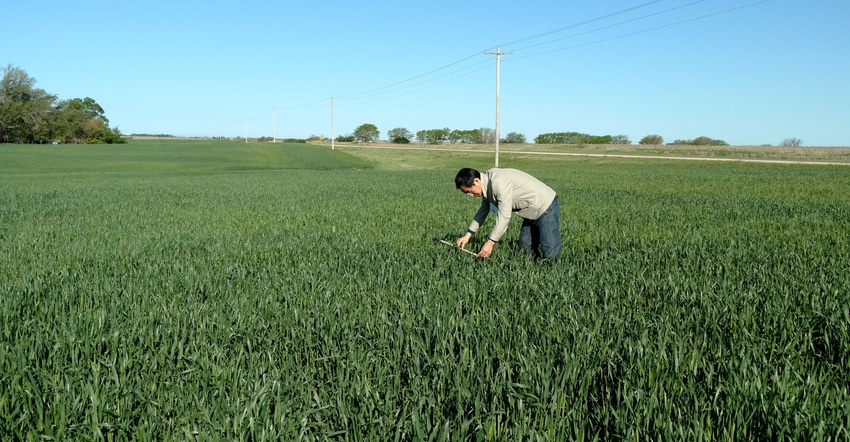June 2, 2020

One event that Kansas wheat growers (and wheat harvest followers) look forward to each year is the Wheat Quality Council’s annual Hard Winter Wheat Tour held the first week of May.
This year the novel coronavirus derailed that traditional event, but Kansas Wheat managed to offer a virtual version of the tour, with yield calculations made in hundreds of fields by crop scouts, Extension agents, agronomists and farmers. Kansas Wheat is estimating the wheat crop at 284.4 million bushels, 7% lower than the May 12 USDA estimate of 306 million bushels and down 16% from last year's production of 338 million bushels.
This estimate is a snapshot in time of the potential of the crop if weather conditions are favorable.
Crop scouts stopped in wheat fields across the state over three days and calculated potential yields using a history-based formula provided by USDA National Agricultural Statistics Service. This formula has traditionally been used by the Wheat Quality Council's Hard Winter Wheat Tour, which is held each year during the first week of May.
This year's tour was canceled due to the COVID-19 pandemic, so a virtual tour was held the week of May 18 by Kansas Wheat and Kansas State University Research & Extension, with support from the Kansas Department of Agriculture. While the virtual tour was based loosely on the WQC's tour, it did not follow the same routes, nor did scouts visit as many fields. This virtual tour gave a broad look at the crop in the lieu of the regular tour.
Virtual tour results
Day 1. The first day covered north-central and northwest Kansas. The north-central district has been plagued by spring drought. Stripe rust is also becoming more prevalent, and barley yellow dwarf was found as well. The spring freeze also had a large effect on the crop in the area. The average yield for north central Kansas was 41.1 bushels per acre.
The crop looked better in northwest Kansas but was still variable. Jeanne Falk Jones, multi-county Extension agronomist, said, "April took a toll on the wheat crop this year with all the cold temperatures." She reported that there was cosmetic leaf burn from cold temperatures on April 2-3 and again on April 12-15. The area has suffered from drought stress, weed pressure due to thin stands, low pressure wheat streak mosaic virus, tan spot and stripe rust. The average yield was 51.7 bushels per acre.
Day 2. The second day covered west-central and southwest Kansas. Gary Millershaski, Kansas Wheat commissioner from Lakin, reported that due to extreme fall and spring drought conditions, many acres of wheat had been abandoned. In addition, planted acres were already down significantly in the area. He said only 30% to 40% of wheat in the area emerged last fall like it was supposed to. The remainder didn't emerge until spring, which will have a negative effect on yield.
"I believe our quantity is going to be down a little bit, but I feel like our quality is going to be unbelievable,” Millershaski said.
Calculated yield for west-central Kansas was 42.5 bushels per acre, and 32.4 bushels per acre for southwest Kansas.
Day 3. The third day covered south-central, central and eastern Kansas. The crop was much improved in these areas; however, stripe rust is evident. Many fields have already been sprayed with a fungicide, but if not, rust will decrease yield potential. South-central Kansas' calculated yield was 49.5 bushels per acres. Central Kansas was 47.6 bushels per acre, and eastern Kansas was 46.5 bushels per acre.
Overall crop yield potential for the state was estimated at 44.5 bushels per acre, 2.5 bushels lower than the USDA estimate of 47 bushels per acre.
More information, including the recordings of each of the virtual meetings, is available online.
Source: Kansas Wheat, which is solely responsible for the information provided and is wholly owned by the source. Informa Business Media and all its subsidiaries are not responsible for any of the content contained in this information asset.
Read more about:
Covid 19You May Also Like




